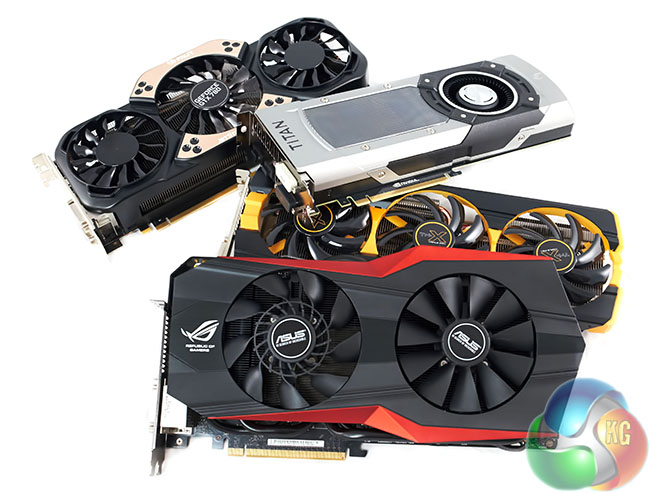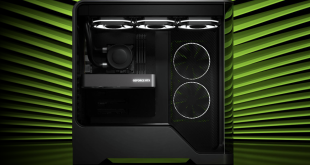Time for a little preamble rant.
One of the biggest GTX780Ti issues for many gamers, is the somewhat limited 3GB of GDDR5 memory. This is continually brought up on our Facebook page by KitGuru readers. It is one of the primary reasons why the Nvidia GTX Titan Black has sold so well into the gaming sector – it is equipped with 6GB of memory. You may not need it right now for every game running at Ultra HD 4K, but 3GB isn't future proofed as we head into 2015.
I still believe Nvidia have marketed the Titan Black very badly, not sending out review samples to publications claiming the card was designed primarily for CUDA developers and professional users, but not gamers. This isn't Chinese whispers – I was told this on the phone when the Titan Black launched, straight from Nvidia PR. So I pulled favours with their partners and got samples sent to me, so I could review it when the product launched. At the time I said it was a great card with a fantastic reference cooler and my opinion hasn't changed.
However, every time we include an Nvidia Titan Black in one of these ‘gaming' oriented reviews, a specific group of enthusiast users say we shouldn't. They have fallen hook, line and sinker for the Nvidia propaganda. Official Nvidia webpages detailing the GTX Titan Black say ‘Evolved from the award-winning GTX TITAN, the Black edition gives you the added horsepower to drive your most graphics-intensive games while still maintaining whisper-quiet acoustics and cool thermals.' This Nvidia page on the official Geforce website claims ‘GTX TITAN Black is the ultimate gaming GPU for a pure gaming experience'. Make up your mind Nvidia.
The older, less powerful GTX780 has been re-released with 6GB of memory, but the GTX780Ti still has to make do with only 3GB. Releasing a 6GB GTX780Ti would simply eat into too many sales of the more expensive Titan Black, and this is why they haven't, yet. Research has shown that over 80% of Titan Black cards are sold to gamers. I love Nvidia hardware and use a Titan Black in my own gaming system, but their pricing methodology can be very tough to justify.

The Asus GTX780 Ti ROG Matrix is a well designed, performance graphics card that incorporates the highest grade components, such as Japanese made 10k black metallic capacitors. Republic Of Gamers products are usually very well engineered, and the ROG Matrix is no exception to the rule.
Nvidia have ruled the single GPU high end market with their GTX780Ti and Nvidia Titan Black now for some time, although many enthusiast gamers find the solutions just too expensive. Many of the GTX780Ti partner cards cost between £549.99 and £599.99 however the ROG Matrix solution is priced even higher, currently available in limited quantity at £649.99 inc vat from OverclockersUK. It is targeting a small audience.
If you are happy with one of the fastest AMD cards such as the Sapphire R9 290X Tri-X OC (which we included in this review today), you can get one on offer from Amazon right now at only £395.90 inc vat. It is certainly not as fast as the Asus GTX780 Ti ROG Matrix, but it is a staggering £250 cheaper.
I was a little disappointed with the overclocking capabilities of the ROG Matrix with the standard air cooling, it was clearly limited to just under 1,200mhz. To be fair, ASUS claim this card is designed to target the ‘hardcore overclocking audience', namely those people using LN2. They say ‘Memory Defroster is a brand-new feature that's designed to excite extreme overclockers. This clever technology quickly defrosts the graphics card's memory during below-zero overclocking to ensure sustained stability. Extreme overclockers will also appreciate the Matrix series' liquid-nitrogen (LN2) jumper switch, as it enables even more overvolting options – allowing the most adventurous users to unleash maximum greater power from their graphics cards.' KitGuru doesn't test with Liquid Nitrogen so we are unable to verify any of these claims.
We still think ASUS would get better out of the box performance by adopting a high grade triple fan cooler like Sapphire, KFA2 and Palit have, but we have mentioned this in reviews before and it seems unlikely to change anytime soon.
Performance from the ASUS GTX780 Ti ROG Matrix at Ultra HD 4K resolution is excellent, although if you are used to frame rates closer to 60 at 1080p, then be aware you would need to buy two GTX780Ti's – yep, silky smooth gaming at 4K is an expensive hobby.
You can pick up one of the ASUS GTX780 Ti ROG Matrix cards from Overclockers UK for £649.99 inc vat. Its a beautiful looking card, clearly designed for the hardcore overclocking audience who will ditch the cooler completely and use a dedicated watercooling kit or even LN2. It is well worth buying, but just falls short of our highest award.
Discuss on our Facebook page, over HERE.
Pros:
- well built, including a backplate.
- highest grade components used throughout.
- ideal partner for 4K gaming.
Cons:
- expensive.
- three high grade fans would be better than two.
KitGuru says: built to the highest standards, but it is expensive and doesn't ship with the greatest air cooler we have tested either.

 KitGuru KitGuru.net – Tech News | Hardware News | Hardware Reviews | IOS | Mobile | Gaming | Graphics Cards
KitGuru KitGuru.net – Tech News | Hardware News | Hardware Reviews | IOS | Mobile | Gaming | Graphics Cards



Why always the talk of 6gb cards? Every benchmark I read suggests it doesn’t help a Titan Black leverage again a 780 Ti. I play games in 4k with two 780 Ti’s in sli and never see my vram usage hit 100%. The issue vs AMD cards is the 384 vs 512 bit bus. A Titan Black is simply wasteful for gaming purposes.
I am looking to get another 780ti for sli 2 way.. I game in 1440p Surround.. Will I be able to obtain 60fps on very high settings?
7680x1440p is very demanding; SLI 980Tis is what I use, but I use my 780Tis for 2650x1440p. I think if the 780Tis had 6GB of VRAM instead of 3GB they would do ok @7680×1440.
So true, I have my Asus Rog Matrix 780ti on ebay as we speak, I will miss it for sure though, decided to go for 980ti’s – for the ports at the back too.